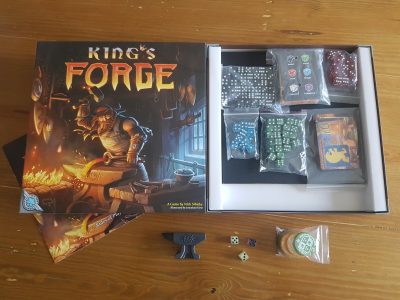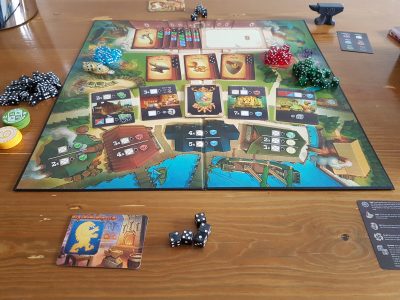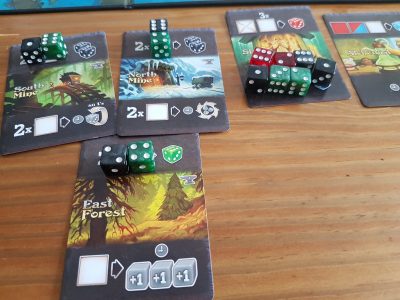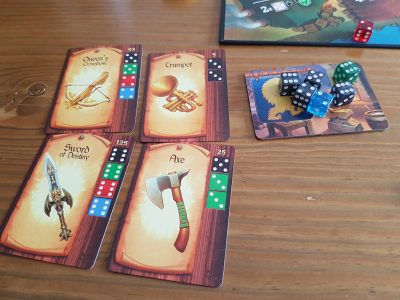King’s Forge is a dice based game for 2 – 4 players from Game Salute. The search is on for a Craftmaster to the King and only a contest stands between players and victory, but which crafter will be crowned the best in the land? Become the first master craftsman to forge four items, made up of weapons and trinkets, for the King to claim victory! Along the way players will utilize resources, such as metal, wood and gems, alongside magic enchantments, which are all represented by dice. However, is King’s Forge a crowning achievement or a dice game to roll off the table? Let’s find out!
King’s Forge is all about six-sided dice. The box holds over 90 of them, ready to be rolled in a mostly 4 main of colours. These colours represent the types of resources the master craftsmen around the table will earn and utilize to forge items fit for the king. There are 32 unique items for players to craft during the game, each with their own combinations of dice scores and colours. Items range from magical weapons such as a Witch’s Brooch or an Arch Wizard’s Orb to more common Trumpets or even Horseshoes. Everything though must be fit for royalty.
The game of King’s Forge is broken down into rounds, each consisting of 3 stages. Firstly, players gain additional resources, obtaining different dice. This is done via a shuffled deck of Gather cards, each with their own unique combinations of potential actions. These range from simply gain a metal dice to spending and sometimes discarding a selection of dice to obtain rarer dice, such as the red gem dice or blue magic die. Other gather cards allow players to manipulate dice in the craft phase or even roll addition dice.
Crafting is stage two. This is where, in turn order, players roll their dice which were not used in the gather stage or just earnt in the gather stage. After rolling the player sees if they can claim any of the three of the available items or steal an item an opponent is trying to craft this round. Each item card has the dice cost made up of differing amounts, material types and dice pip values. For example a player could try to craft the Ice Sword, if it was one of the three available. The Ice Sword has a cost of 2 metal (black) dice, both showing 5, and 2 magic (blue) dice, showing 3 and 4. A player would need to roll a minimum of 4 dice made up of 2 metal and 2 magic to even be able to craft the item and then only if the rolled dice have values above the requirement.
The third stage is the least eventful as it is time for board clean up. The first player anvil is passed clockwise to the next player and the gather cards are collected and reshuffled ready for the start of the next round. Dice used for gather cards are either returned to the player or discarded back to the bank, depending on the type of gather action they were used for. Dice earnt in the previous round are moved from each players’ individual smithy tiles into their active dice pools and the new round commences. This happens until one player has crafted 4 items and is declared the winner!
One mechanic of Kings Forge which did confuse players and caused me to re-read the rules a handful of times is dice are not spent when crafting. Whether players are successful or not when crafting an item for the King the dice are returned to the player’s dice pool. I understand returning dice that were not used but, given the finite dice pools, I found house ruling dice are used when successfully in crafting stopped players snowballing too much. This also makes more sense logically that materials used to successfully make an item cannot be re-used to make something else. In a 2 player game the finite dice pools aren’t an issue. At higher player counts especially the black dice, which are metal in lore, can run out as they are the easiest to obtain. Dice being added back into the piles via crafting just helped keep things flow.
Taking around an hour to play King’s Forge is light enough players feel ready for more, whilst being weighty enough so that players don’t see it as a filler title. Even players whom swore the dice were against them looked forward to playing again: hoping their odds would change. Some may dislike the random nature of dice based games, leading towards luck based outcomes. I certainly have found to be victim to the dice gods when playing King’s Forge but with the sheer quantity of dice being rolled the odds are often not against you.
Interestingly going later in the turn order can be more beneficial. This seems counterintuitive to most gamers where going first is always considered an advantage to balance out. Some advantage is there as first player does have the option of what to attempt craft wise first and first choice in the Gather stage. However, when crafting subsequent players can attempt to steal crafted items. This means that in a 4 player game the player whom goes last in the Crafting round could choose to steal from any previous player, scuppering best made plans.
King’s Forge revolves around the dice but leaves enough room for the cards and game board to shine. Despite only limited amounts the artwork there is a consistency and pleasant nature to the illustrations. The board depicts a small section of a medieval town which is carefully used to split up regions for the dice pools, Gather and Craft cards. The way these elements are designed into the illustration is impressive, such as the wood pile for wooden dice or the mine entrance for the metal dice. It makes sense where the many dice go from the artwork and I particularly enjoy the way additional Gather options are built into buildings alongside the river. The items are also done in a similar art style keeping the consistent theming running throughout.
The mechanic of lowest to highest when it comes to the complexity, or the odds, of crafting items works extremely well. A simple trumpet for instant requires a roll of two 3’s on metal dice while the Sword of Destiny costs a six on each material dice. The odds of rolling the dice scores needed for the Sword of Destiny harder. Also, to get the range of material dice needed players will have had to committed more towards one individual item. The brilliance of the mechanic is, at the start of the game new players can quickly acquire, or craft, one of the ‘easier’ items. Then when players have more of an understanding the difficulty is self-inflated as more items are crafted. It’s a natural way for the difficulty to rise throughout the game and results in no one player feeling victimised by the timing of the difficult changes.
King’s Forge is a prime example of a game I have had to give a chance. After my first game, which was made up of both a heavy loss and a decent amount of consulting the rulebook, things weren’t exactly going royally. Past this first game not only did the entire game speed up but the Gather cards started to become more instinctive and the fun truly started to flow throughout the game. A 2-player game is a lot more cutthroat when it comes to stealing but I enjoyed this counter based style of gameplay. If you dislike dice this might be one to miss. Conversely, if you love the odds and probabilities dice throw into the mix King’s Forge may have been crafted just for you.
[Editor’s Note: King’s Forge was provided to us by Game Salute for review purposes.]





